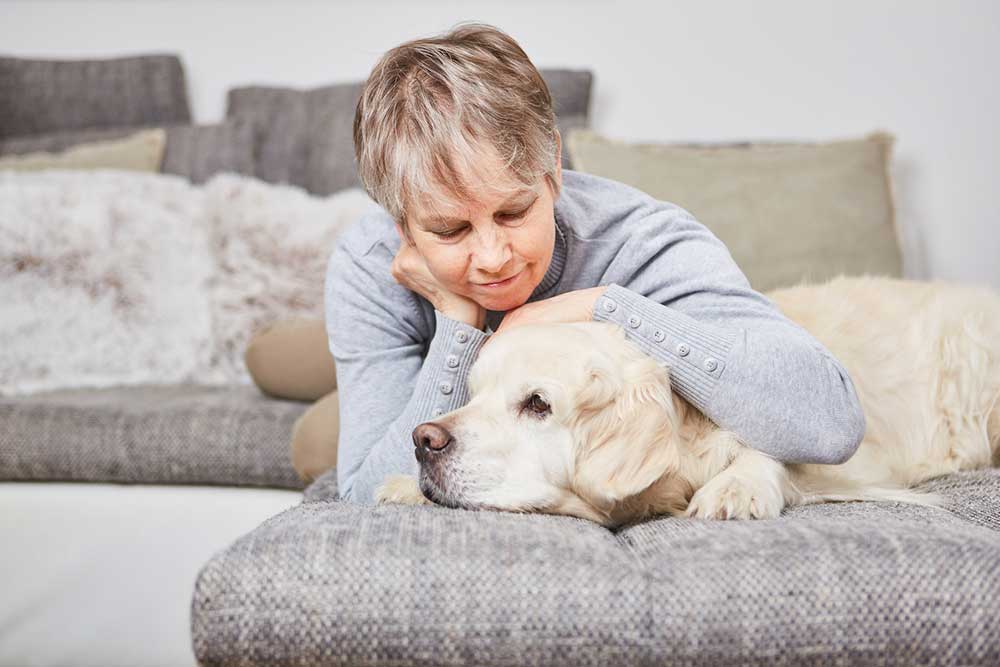Your dog’s poop can tell you a lot about their health, so it’s important to pay attention to it. When blood shows up in their stool (poop), it’s almost certainly an indication that something is wrong — perhaps seriously so.
What Does Blood in Dog Poop Look Like?
Dogs typically have two types of bloody stools, and one looks different from the other. Being able to tell your vet which type of bloody stool your dog has can help them narrow down a possible cause and assess your dog’s condition more quickly.1
-
Bright red blood. Referred to by vets as hematochezia, this is bright red, fresh-looking blood in the stool or dripping from the anus. This can indicate issues with the lower digestive tract, colon or rectum.1
-
Dark red or black, tarry stool. Referred to as melena, this is older blood that has been swallowed or has gone through the digestive tract. This could indicate a number of different health issues ranging from not serious to very serious.1
It’s also important to keep in mind that eating red food or nonfood items can cause your dog’s poop to turn red or have red streaks.1 When in doubt, the safest thing to do is to check with your vet.
Learn More
Find a Veterinarian Near You
Possible Reasons Your Dog Is Pooping Blood
Blood in a dog’s stool could have a lot of different causes — ingesting blood from an external wound, digestive issues, parasites, cancer and other serious illnesses. Below are 15 of the most common reasons why your dog might be pooping blood.
1. They ate something toxic.
If your dog swallows something poisonous or toxic, their system may react dramatically in an attempt to purge it. This can result in bright red blood in their stool.2
Other symptoms of poisoning include diarrhea, vomiting, appetite loss, lethargy, unsteadiness and seizures.3 If you suspect your dog has been poisoned, you should get them to a vet as soon as possible.
2. They ate something inedible.
Dogs are notorious for eating things they shouldn't. Sticks, rocks, pieces of a chew toy, your favorite shoe — it’s all fair game. Swallowing such nonfood items can cause internal damage and bleeding in the digestive system that appears in their stool as tarry and dark red or reddish black. They might also show signs of stomach pain and other symptoms like vomiting, lethargy, seizures or unresponsiveness. Your vet should see your dog as soon as possible to assess the damage and provide treatment.2
3. Their bowels are inflamed.
Dogs can suffer from inflammatory bowel disease (IBD), which is a response to chronic intestinal irritation.4 This can cause both types of bloody dog poop.2 Dogs with IBD typically have chronic diarrhea and may also exhibit a lack of interest in food.4 While it’s not an emergency, your vet should examine your dog so they can determine and treat the underlying cause.
4. They have an infection.
Dogs, especially puppies, are susceptible to bacterial and viral infections, which can cause bloody diarrhea. This is usually accompanied by other symptoms like vomiting, lethargy, dehydration and appetite loss. Any diarrhea that accompanies these symptoms — with or without blood in the stool — should be your cue to quickly get your pup to a vet. Some infections, like parvovirus, can be deadly if not treated in time.2
5. They have parasites.
Worms and other parasites in the digestive tract can cause internal bleeding that results in bright red blood appearing in the stool.2 A parasitic infection might also cause diarrhea and vomiting.2 Your vet will need to examine a sample of your pup’s poo to determine whether parasites are the cause.
6. They have an ulcer.
Stomach ulcers — open sores in the lining of the stomach — can also cause black, tarry dog poop. Ulcers can be caused by a lot of different things, but the possibility increases when your dog takes nonsteroidal anti-inflammatory medications (NSAIDs) or corticosteroids. Other symptoms typically include vomiting up blood, vomiting in general, weight loss, excessive drooling, lethargy and fever. Your dog should see a vet if they show these signs and will likely get better with proper diagnosis and treatment.5
7. They’re allergic to something they ate.
A food allergy is an overactive immune response to an ingredient in your dog’s food. Symptoms include other gastrointestinal issues like vomiting and diarrhea, as well as skin reactions like itching or redness.6
While this isn’t life-threatening, it can definitely make life uncomfortable for your dog. Your vet can help you discover the source of the allergy and manage the symptoms to provide your pooch with relief.
8. They have an injury.
Internal injuries to the digestive system or the rectum can cause a dog to poop bright red blood.2 Darker blood could appear if they swallow blood from trauma located somewhere else on the body.1 If they show signs of pain, or if they exhibit no other symptoms and the blood persists, you should have a vet examine them for injury as soon as possible.
9. They have kidney or liver disease.
Disease and failure of both the liver and kidneys could produce the dark red or black tarry type of blood in a dog’s stool. Other signs include diarrhea and excessive thirst or dehydration. These are serious health issues, and the sooner your dog is diagnosed and treated, the better. So don’t hesitate to take your dog to the vet if you notice these symptoms.2
10. They have pancreatitis.
Pancreatitis is an acute and potentially fatal illness that occurs when pancreatic enzymes begin devouring the pancreas. It can have several causes, but it’s most common in dogs with high-fat diets.7
This is another potential cause of dark, tarry dog stools.8 Other signs include a distended abdomen, hunched back, excessive vomiting, diarrhea, weakness, appetite loss and fever.7 This is a dangerous condition, and dogs showing these signs should be taken to an emergency vet immediately.7
11. They have colitis.
Colitis is an inflamed large intestine. It can be acute or chronic, and it can be caused by many of the things on this list. Chronic colitis can also be caused by an autoimmune disorder in which the immune system attacks the colon. Colitis is often a cause of mucousy diarrhea in dogs, which may also contain blood. If you see this, you should call your vet.9
12. They have Addison’s disease.
Addison’s disease, also known as hypoadrenocorticism, refers to an underactive adrenal system. Among other health issues, this can cause severe gut issues that result in bloody dog stool. Besides gastrointestinal symptoms, other signs include depression, lethargy, appetite loss, weight loss, hair loss, increased thirst and increased urination. Untreated Addison’s disease can shorten your dog’s lifespan and reduce their quality of life; but with proper treatment and management, your dog can live a long and normal life.10
13. They have an intestinal blockage.
Intussusception is the medical term for when part of the intestine telescopes in on itself, creating an intestinal blockage that prevents food from passing through. Along with bloody stool, this can cause vomiting, diarrhea, depression and appetite loss. It might also cause your dog pain and swelling in the abdomen. In some cases, this can improve on its own, but it most often requires surgery to repair.11
14. They have issues with their anal glands.
A dog’s anal glands contain scented liquid that should release when they relieve themselves, helping to mark their territory. But sometimes the anal sacs don’t empty as they should and need to be manually expressed by a vet. If this doesn’t get done, the anal gland can become blocked and inflamed, leading to an abscess. An abscessed anal sac may bleed and cause bright red blood to coat your dog’s poop. If your dog is scooting their butt on the floor or chewing and licking back there, you should contact your vet to have their anal glands looked at.12
15. They have a tumor.
Both cancerous and noncancerous tumors can cause dark, tarry blood to appear in your dog’s stool.2 However, this is more common with cancerous tumors.2 Other signs of cancer in dogs include appetite and weight loss, unexplained bad odor, depression or lethargy and other problems with relieving themselves.13
While there are many reasons there may be blood in your dog's poop, you and your pup will want to pay a visit to your veterinarian to determine the cause and figure out the best treatment.
Frequently Asked Questions About Dog Pooping Blood
Do you still have questions about blood in your dog's poop? Here are answers to some commonly asked questions.
CareCredit Credit Card Financing for Dogs
Taking good care of your pet's well-being from nose to tail is essential. Make sure to stay up to date on their regular checkups at the vet to help keep your pet happy and healthy for a lifetime of love. You can use your CareCredit credit card for pet care throughout the year for routine veterinary services as well as emergencies and surgeries.* Use our Acceptance Locator to find a veterinarian near you that accepts CareCredit.
CareCredit is there for you and your pet every step of the way. Continue your wellness journey by downloading the CareCredit Mobile App to manage your account, find a provider on the go and easily access the Well U blog for more great articles, podcasts and videos.
In addition to pet care, you can also use your CareCredit credit card for dentistry, cosmetic, vision, hearing, health systems, dermatology, pharmacy purchases, spa treatments and so much more within the CareCredit network. How will you invest in your health and wellness next?
Author Bio
Jean Marie Bauhaus is a freelance writer and novelist who has been writing pet content since 2013. Her work has appeared on Forbes.com, Hill's Pet, Chewy, AKC.org and more.







